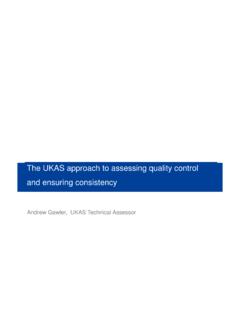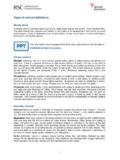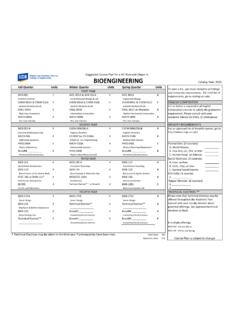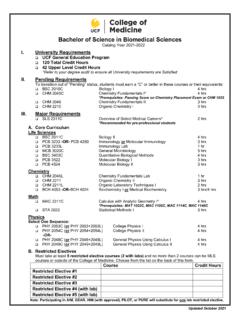Transcription of A SN1 Reaction: Synthesis of tert-Butyl Chloride
1 Supplementary information for Comprehensive organic chemistry Experiments for the Laboratory Classroom The Royal Society of chemistry 2017 A SN1 Reaction: Synthesis of tert-Butyl Chloride Supplementary Material Experiment Notes: This lab experiment proposes the Synthesis of an alkyl halide by reacting the corresponding alcohol with a hydrogen halide in an easy and inexpensive SN1 ,2 tert-Butanol reacts readily with HCl and forms the corresponding tert-Butyl Chloride at room temperature.
2 SN1 mechanisms are unimolecular because its slow step is unimolecular. The reaction proposed involves an initial step where the tert-butyloxonium ion is formed by protonation. This ion then dissociates to a second intermediate a carbocation - an ion that contains a positively charged carbon. Since only one species, tert-butyloxonium ion, undergoes a chemical change in this step, the step is unimolecular. This is the rate-controlling step. The carbocation (tert-butylcation) being strongly electrophilic then reacts with the nucleophile Chloride ion in a fast step originating the tert-Butyl Chloride final product Scheme SM Since the nucleophile is not involved in the rate determining step of the process a strong nucleophile is not important in this process.
3 More stable carbocations are formed faster than the less stable ones. That stability is conferred by hyperconjugation - electron delocalization via orbital overlap. Therefore the SN1 mechanism is generally accepted to be correct for the reaction of tertiary and secondary alcohols with hydrogen halides but not for methyl and primary alcohols as methyl and primary carbocations are too unstable to be reasonably involved. Instead methyl and primary alcohols will suffer an initial protonation and then react slowly by a bimolecular SN2 mechanism.
4 Therefore if the same conditions were applied to n-butanol just small amount, if any, of 1-chlorobutane would be obtained. Supplementary information for Comprehensive organic chemistry Experiments for the Laboratory Classroom The Royal Society of chemistry 2017 (CH3)3C:O:H+HCl:..(CH3)3C:OHH+fastStep 1:Step 2:Step 3:(CH3)3 COH+HCl(CH3)3 CCl+HOH(CH3)3C:OHH+slow(CH3)3C++H2O+: (CH3)3C++: (CH3)3 CCl:..fasttert-ButylalcoholHydrogen chloridetert-ButylchlorideWaterThe overall reactiontert-ButylalcoholHydrogen chloridetert-ButyloxoniumionChloride iontert-Butyloxoniumiontert-ButylcationW atertert-ButylcationChloride iontert-Butylchloride Scheme SM Mechanism for the formation of tert-Butyl Chloride from tert-Butyl Alcohol and Hydrogen Chloride The importance of SN1 experimental conditions will be emphasised to the students with this experiment.
5 While conducting the reaction, the use of vigorous magnetic stirring in an uncapped Erlenmeyer is important to promote a close contact among the reactants. To avoid any reaction mixture spilling it is advisable to adjust an air condenser to the clamped jointware Erlenmeyer during the reaction course . Alternatively, the reaction can be carried out in a 250 mL separatory funnel, shaking for about 10 minutes with the appropriate cautions: slow swirling until all the gas is extruded from the medium and Supplementary information for Comprehensive organic chemistry Experiments for the Laboratory Classroom The Royal Society of chemistry 2017 frequently opening of the funnel stopper to release internal pressure, followed by a more vigorous shaking.
6 Care must be taken in this operation to avoid over-pressure inside the stopper separatory funnel. The reaction mixture is then transferred from the Erlenmeyer to the separatory funnel, and the discharge of the different acid and alkaline aqueous phases should be done with care. The reaction mixture treatment includes an initial neutralization with CO2 formation, and care must be taken to avoid over-pressure inside the separatory funnel; an initial slow swirling until most of the gas liberates followed of a slow shaking with pressure equilibration followed by a more vigorous shaking and subsequent phase separation.
7 After the reaction mixture treatment, the organic phase must be dried with enough anhydrous sodium sulphate, which must be added in small portions with careful swirling, to avoid the excess of that agent. The dried solution is then filtrated by gravity to a round bottom distillation flask. Care should be taken to hold the funnel over the round bottom flask such that the air leaves as the filtrate flows to the flask in order to avoid over-pressure in the distillation flask.
8 Before the simple distillation, make sure that the round bottom flask, with the appropriate boiling stones or magnetic stirrer, is properly fixed with a clamp inside the heating mantle or in a water / oil bath over a heating plate, not touching the heating equipment to avoid over-heating during the distillation. All the glass jointware should be properly adjusted avoiding any vapour leakage, and the condenser must be properly fixed. After everything set up figure SM - make sure the temperature can be easily registered and the graduated cylinder to recover the product has the weight registered.
9 Then the distillation operation must start. Since the product fraction has a boiling temperature between 48 and 52 C, a very slow heat increase is advisable and the recover equipment should be kept in an ice bath. After product recovery the distillation heating should be turned off and let to cool down before disconnecting the distillation equipment. The recover joint glass graduated cylinder with the distilled Supplementary information for Comprehensive organic chemistry Experiments for the Laboratory Classroom The Royal Society of chemistry 2017 product must be capped before taken from the ice bath, out-cleaned not to be wet and then weighted.
10 The distillation operation should be done in a fume cupboard. With the obtained volume and weight of the product, the reaction yield must be calculated, making note of the limiting reagent in this specific reaction. This organic chemistry experiment has been performed by Pharmaceutical Sciences degree students (1st year) for more than 20 years in the organic chemistry laboratory of Pharmacy Faculty Universidade de Lisboa, Portugal. Typical yields vary between 40% and 65%. Vigorous shaking/stirring is an important factor to obtain good yields.













